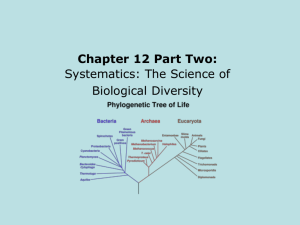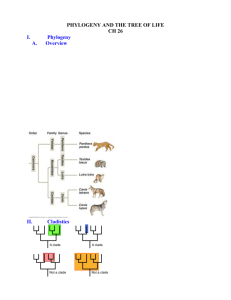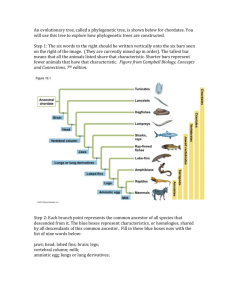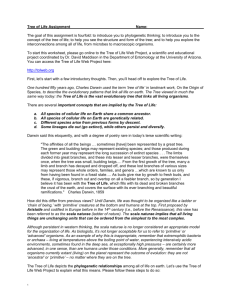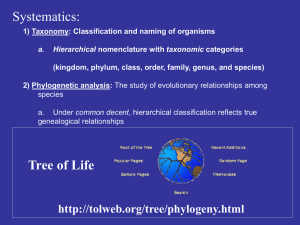Systematics – Chapter 12
advertisement
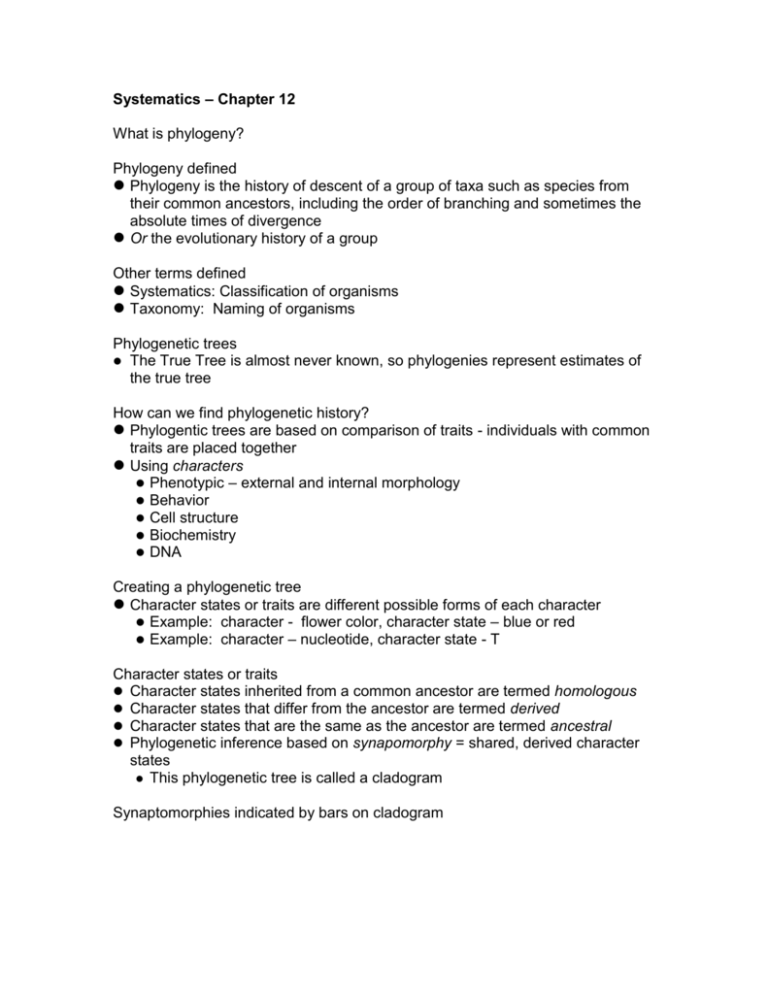
Systematics – Chapter 12 What is phylogeny? Phylogeny defined Phylogeny is the history of descent of a group of taxa such as species from their common ancestors, including the order of branching and sometimes the absolute times of divergence Or the evolutionary history of a group Other terms defined Systematics: Classification of organisms Taxonomy: Naming of organisms Phylogenetic trees The True Tree is almost never known, so phylogenies represent estimates of the true tree How can we find phylogenetic history? Phylogentic trees are based on comparison of traits - individuals with common traits are placed together Using characters Phenotypic – external and internal morphology Behavior Cell structure Biochemistry DNA Creating a phylogenetic tree Character states or traits are different possible forms of each character Example: character - flower color, character state – blue or red Example: character – nucleotide, character state - T Character states or traits Character states inherited from a common ancestor are termed homologous Character states that differ from the ancestor are termed derived Character states that are the same as the ancestor are termed ancestral Phylogenetic inference based on synapomorphy = shared, derived character states This phylogenetic tree is called a cladogram Synaptomorphies indicated by bars on cladogram The problem of homoplasy Homoplasy complicates the building of phylogenetic trees Homoplasy is the possession by two or more groups of a similar or identical character state that has not been derived by both species from their common ancestor; includes convergence, parallel evolution and evolutionary reversal Convergent evolution Similar character states evolve independently in different lineages due to similar natural selection pressures Parallel evolution Similar character states evolve independently in related lineages Solution to homoplasy Use slowly evolving characters Use multiple lines of evidence Morphology DNA sequences Which tree is correct? Use principle of parsimony The simplest explanation is the best explanation Most widely used method, but not perfect Best tree is the one that has the fewest evolutionary changes Tree length and maximum parsimony Molecular clocks DNA sequences may evolve at a constant rate This “molecular clock” may allow us to estimate the absolute time of divergence Clock will vary from gene to gene, lineage to lineage and base to base Evidence for a molecular clock Difficulties Some events (such as adaptive radiation) happen too quickly to develop distinct synapomorphies Adaptive radiation is common Adaptive radiation is the divergent evolution of a lineage within a relatively short time Mammal and angiosperm diversification during Mesozoic and Cenozoic Cichlid fishes in rift lakes of Africa Darwin’s Finches on the Galapagos Islands Honeycreepers in Hawaii What causes adaptive radiations? Opportunity Colonization of isolated habitats Cuts off gene flow Many new niches available Lack of competition Mass extinction Climate Change Evolutionary innovation Colonization of isolated habitats Mass extinctions Evolution of land plants includes major innovations Three kingdom system Kingdom Fungi Eukaryotic, multicellular absorbers More closely related to animals than plants Kingdom Protista Unicellular, colonial, and simple multicellular eukaryotes Kingdom Plantae Includes eukaryotic, multicellular photosynthesizers Primarily sexual reproduction with cycles of haploid and diploid generations Alteration of generations The first eukaryotic organisms were probably haploid Zygotic meiosis Evolution of delayed meiosis (gametic meiosis) results in production of gametes In plants meiosis (sporic meiosis) results in the production of spores Spores can divide by mitosis and produced a multicellular haploid organism Kingdom Fungi – Chapter 14 Fungi Hetertropic organisms Absorbers due to rigid cell walls made of polysaccharide chitin Most fungi are filamentous Each filament is called a hyphae and a mass of hyphae from one organism is called a mycelium 70,000 species identified Fungi are important as decomposers Medical and economic mycology Cladosporium herbarum attack meat Fungal infections Yeast Antibiotics Fungal symbioses 80% of all vascular plants have mycorrhizal relationships Endophytes live inside leaves of healthy plants and produce protective secondary metabolites Lichens include mycobiont and photobiont Predaceous fungi Classification of fungi Cytridiomycota Predominantly aquatic group Motile cells Do not develop mycelium Zygomycota Most live on decaying organic matter Some are parasites, endomycorrhizae Profuse, rapidly growing hypae Form zygospores Ascomycetes Food spoilage fungus Powdery mildews Yeasts Form ascospores Basidiomycetes Most familiar fungi Include gill fungi Forms basidiospores

